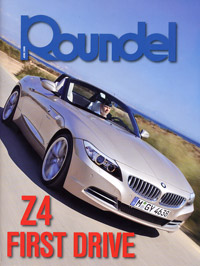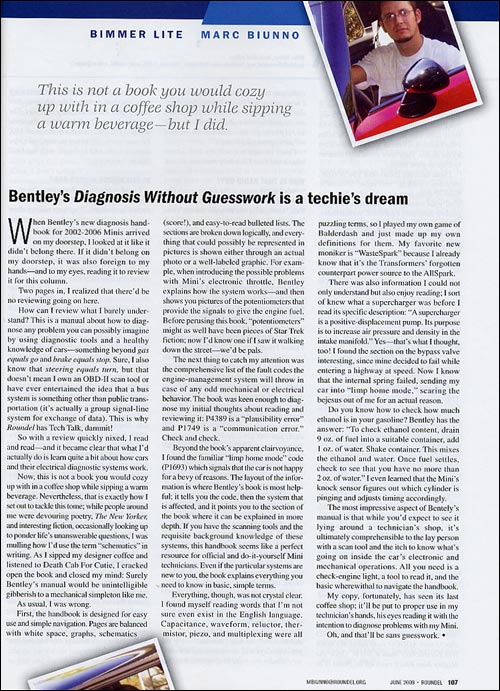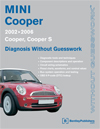|
|
MINI Cooper
Diagnosis Without Guesswork: 2002-2006
Price: $89.95
|

Roundel - June 2009
Bentley's Diagnosis Without Guesswork is a techie's dream
When Bentley's new diagnosis handbook for 2002-2006 Minis arrived on my doorstep, I looked at it like it didn't belong there. If it didn't belong on my doorstep, it was also foreign to my hands-and to my eyes, reading it to review it for this column.
Two pages in, I realized that there'd be no reviewing going on here.
How can I review what I barely understand? This is a manual about how to diagnose any problem you can possibly imagine by using diagnostic tools and a healthy knowledge of cars-something beyond gas equals go and brake equals stop. Sure, I also know that steering equals turn, but that doesn't mean I own an OBD-11 scan tool or have ever entertained the idea that a bus system is something other than public transportation (it's actually a group signal-line system for exchange of data). This is why Roundel has Tech Talk, dammit!
So with a review quickly nixed, I read and read-and it became clear that what I'd actually do is learn quite a bit about how cars and their electrical diagnostic systems work.
Now, this is not a book you would cozy up with in a coffee shop while sipping a warm beverage. Nevertheless, that is exactly how I set out to tackle this tome; while people around me were devouring poetry, The New Yorker and interesting fiction, occasionally looking up to ponder life's unanswerable questions, I was mulling how I'd use the term "schematics" in writing. As I sipped my designer coffee and listened to Death Cab For Cutie, I cracked open the book and closed my mind: Surely Bentley's manual would be unintelligible gibberish to a mechanical simpleton like me.
As usual, I was wrong.
First, the handbook is designed for easy use and simple navigation. Pages are balanced with white space. graphs, schematics (score!), and easy-to-read bulleted lists. The sections are broken down logically, and everything that could possibly be represented in pictures is shown either through an actual photo or a well-labeled graphic. For example, when introducing the possible problems with Mini's electronic throttle, Bentley explains how the system works-and then shows you pictures of the potentiometers that provide the signals to give the engine fuel. Before perusing this book, "potentiometers" might as well have been pieces of Star Trek fiction; now I'd know one if I saw it walking down the street-we'd be pals.
The next thing to catch my attention was the comprehensive list of the fault codes the engine-management system will throw in case of any odd mechanical or electrical behavior. The book was keen enough to diagnose my initial thoughts about reading and reviewing it: P4389 is a "plausibility error" and P1749 is a "communication error." Check and check.
Beyond the book's apparent clairvoyance, I found the familiar "limp home mode" code (P1693) which signals that the car is not happy for a bevy of reasons. The layout of the information is where Bentley's book is most helpful; it tells you the code, then the system that is affected, and it points you to the section of the book where it can be explained in more depth. If you have the scanning tools and the requisite background knowledge of these systems, this handbook seems like a perfect resource for official and do-it-yourself Mini technicians. Even if the particular systems are new to you, the book explains everything you need to know in basic, simple terms.
Everything, though, was not crystal clear. I found myself reading words that I'm not sure even exist in the English language. Capacitance, waveform, reluctor, thermistor, piezo, and multiplexing were all puzzling terms, so I played my own game of Balderdash and just made up my own definitions for them. My favorite new moniker is "WasteSpark because I already know that it's the Transformers' forgotten counterpart power source to the Allspark.
There was also information I could not only understand but also enjoy reading; I sort of knew what a supercharger was before I read its specific description: "A supercharger is a positive-displacement pump. Its purpose is to increase air pressure and density in the intake manifold." Yes-that's what I thought, too! I found the section on the bypass valve interesting, since mine decided to fail while entering a highway at speed. Now I know that the internal spring failed, sending my car into "limp home mode," scaring the bejesus out of me for an actual reason.
Do you know how to check how much ethanol is in your gasoline? Bentley has the answer: "To check ethanol content, drain 9 oz. of fuel into a suitable container, add 1 oz. of water. Shake container. This mixes the ethanol and water. Once fuel settles, check to see that you have no more than 2 oz. of water." I even learned that the Mini's knock sensor figures out which cylinder is pinging and adjusts timing accordingly.
The most impressive aspect of Bentley's manual is that while you'd expect to see it lying around a technician's shop, it's ultimately comprehensible to the lay person with a scan tool and the itch to know what's going on inside the car's electronic and mechanical operations. All you need is a check-engine light, a tool to read it, and the basic wherewithal to navigate the handbook.
My copy, fortunately, has seen its last coffee shop; it'll be put to proper use in my technician's hands, his eyes reading it with the intention to diagnose problems with my Mini.
Oh, and that'll be sans guesswork.

Review of MINI Cooper - Diagnosis Without Guesswork: 2002-2006 from Roundel - June 2009
![[B] Bentley Publishers](http://assets1.bentleypublishers.com/images/bentley-logos/bp-banner-234x60-bookblue.jpg)
